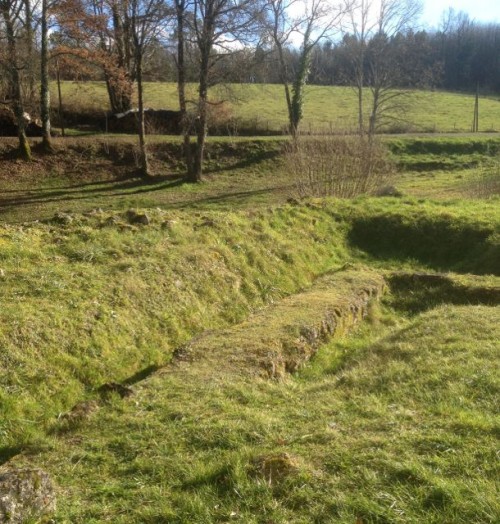There is an academic field called historical geography. My sister-in-law told me about it once. It studies the physical traces of civilization on the landscape. When people occupy a place, they build and dig and leave tracks. Over hundreds of years, these tracks may become overgrown and lose their purpose. However, a trained eye can still see them in the landscape and uncover what they once were. For example, what looks like a slight depression in the ground could once have been a medieval grain store. Or a peculiar ridge near a town could once have been a city fortification. The landscape holds clues to who once was there. Clues to be solved. This appeals to my inner detective and I love it when I solve one of these puzzles.
Today on my walk, I passed a square pond made of stone. It was fed by a nearby stream and had some pipes sticking out of it. It was overgrown, mossy and neglected. I assumed it was some part of a drainage system set up by a resourceful farmer and then abandoned. As I passed, I noticed something puzzling. Set into the pond were four triangular stones carved with regular ridges. The stones extended beneath the surface of the water. In a lightbulb moment, I realized this was the laverie, the pool where the farmer’s wife washed her clothes. Suddenly I imagined her there with baskets of sheets and petticoats. The pond was a good distance from the nearest house. Poor woman. Understandably, the minute she got her first washing machine, she never came here again and it was left to the ivy and insects. I was delighted by my discovery and congratulated myself on this detective work. Simple deduction, Another case solved.
There are many of these landscape clues in Ireland. In fact, there are so many, nobody bothers trying to solve them. For example, the fields are dotted with small grassy mounds. They’re shaped too uniformly to be natural and they’re not. They’re prehistoric cairns – as in stonehenge time. Most have never been excavated and the farmer just ploughs around them. Anyplace else, there’d be a visitor centre. When I lived there, I was always itching to dig into one and find a priceless gold armband. (I’m a treasure hunter as well as being a detective.) Another Irish example might be better called “superstitious geography” Once I was walking with an irish fellow and we came to a castle ruin. There was no roof and trees grew out of the centre. Perched in the trees was a flock of big, ugly, menacing rooks. He told me very solemnly that rooks gathered at places where violence had occurred between men. A cloud blocked the sun. The rooks flapped and cawed and glared at us with beady eyes. I was inclined to believe his story.
I’d guess Europe has more of these landscape puzzles than America. More things are made out of stone here and Europeans are content to just leave them alone. Americans bulldoze and build something new. Sometimes in western Kansas, you’ll see stands of dejected scraggly trees in the middle of a wheat field. They look out of place because they are out of place. Few trees grow there on their own initiative and these were planted by a homesteader. Congress passed the Timber Claim Act in 1873. They sincerely believed that more trees would bring rainfall to the dry plains. If a farmer planted 40 acres of trees, he could get an extra 160 acres of land. This doubled the previous amount he could claim and seemed like a good deal. How hard would it be to grow trees? The farmers broke their backs dragging water to the the seedlings and protecting them from grasshoppers, prairie fires, tornadoes, blizzards, and the scorching wind. Mostly, the trees didn’t grow. The few stragglers you can still see are lonely symbols of this misguided policy and crushing work. At least 60% of homesteaders gave up on the prairie and never received title to their claim. Maybe that’s another reason why there are few landscape clues in the states. Americans don’t like to be reminded of failure.
Sometimes I wonder about the tracks I am leaving behind. We built a brick garage in our back garden in Doesburg. It looks solid enough now but could become a swimming pool with the stroke of a planning permission pen. My stonework is placed here and there but could be torn out to make way for a new convention centre. Even gravestones fall over or are replaced if nobody visits anymore. It’s hard to think of something really permanent.
I’m not sure if this counts, but I planted a hundred crocus bulbs in the lawn of our house in Sussex. It would be hard to dig them out of the grass and I’m pretty sure nobody will bother. They’ll keep spreading. It is a modest legacy but I’m pleased enough with it. We should all leave a little memory in the landscape.



Shelly Heideman says
Great story, Julie! Takes me back to Grandma O’Brien’s house!
Love you,
deb says
Makes me think of the wagon wheel ruts that can still be seen on the Oregon Trail. http://www.eg.bucknell.edu/~hyde/jackson/lindaOregonTrip.html
julierezac@btconnect.com says
thought about that too